Easy Homemade English Muffins with Fresh Milled Flour
You know when you tear open a bag of English muffins, pop them in the toaster, and then those little nooks and crannies catch all the melted butter, gooey jam, or whatever you’ve piled on top?
Now imagine that—but more nutritious and made by your hands. A whole wheat version made with fresh milled flour, right from your kitchen. This homemade recipe, dare I say it, beats even Thomas’s English Muffins!
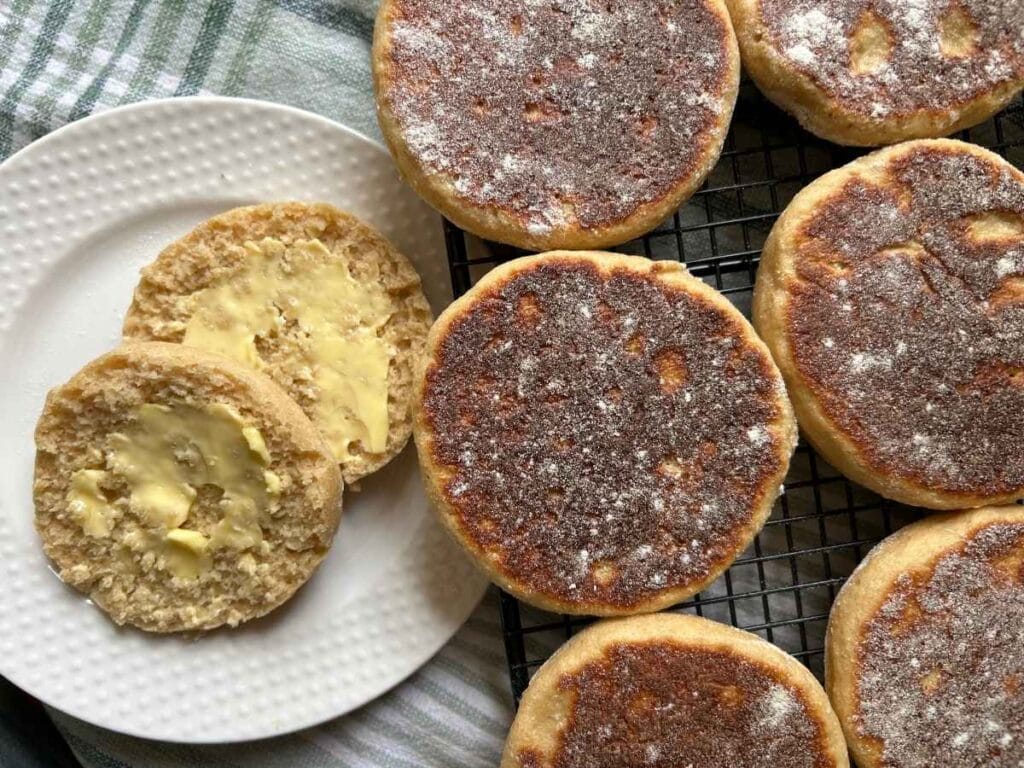
I’ve been milling my own flour for a few years now, and there’s something so satisfying about turning wheat berries into dough, waiting for that rise, and cooking them on a griddle. The outside gets golden while the inside stays soft and chewy. Those factory-flavored muffins don’t hold a candle to the aroma and taste of fresh English muffins straight from the griddle.
Let’s dive into this recipe for easy English muffins with fresh-milled flour. Trust me: once you try these, you’ll wonder why you ever settled for store-bought.
Try more fresh milled breads like Zucchini Muffins, Milk & Honey Cornbread, Texas Roadhouse Copycat Rolls, Pumpkin Pecan & Raisin Muffins, Dinner Rolls, Ciabatta Rolls, Maple Pecan Banana Bread, or Super Soft Milk Bread.
Want some whole wheat sourdough recipes? Try Sourdough English Muffins, Sourdough Challah, Sourdough Sandwich Bread, Cheesy Sourdough Focaccia, or Sourdough Chocolate Chip Banana Muffins.
This post contains affiliate links. As an Amazon associate or other affiliate, I earn from qualifying purchases. We try to recommend products we personally use or have used and trust. If you choose to purchase through our links in this post, we may receive a commission, at no extra cost to you. Read the full disclosure here.
Why You’ll Love This English Muffin Recipe
This English muffin dough has no weird preservatives or ingredients, and you get real, whole grain bread. Using fresh milled whole grains means the germ and bran are still included, so you get deep, nutty tones that store-bought just can’t replicate. This means more fiber, more nutrients, and more goodness from wheat berries.
Those classic nooks and crannies are perfect for butter and homemade jam, over-easy egg breakfast sandwiches. Plus, the smell while they bake on the griddle? Chef’s kiss.
These buns are freezer-friendly, so you can make a batch, freeze the extras, and pull them out when you want a breakfast that feels fancy without all the work.
New to Fresh Milled Flour? Read more about it in our Beginner’s Guide or more about the Best Grains to Use.
Homemade English Muffins
Tools
- Grain Mill
- Stand Mixer with Dough Hook Attachment (I love my KitchenAid or Zacme)
- Large Cast Iron Skillet or Electric Griddle
- Biscuit cutter or round cutter (about 3 in)
- Cooling Wire Rack
- Plastic Wrap
- Kitchen Scale
- Cornmeal or Rice Flour for dusting
- Parchment Paper
- Baking Sheet
- Kitchen Thermometer
Ingredients
- 425 grams Warm Milk (1.75 Cups)
- 43 grams Unsalted Butter (3 Tablespoons), softened
- 6 grams Salt (1.25 teaspoons)
- 25 grams Honey (2 Tablespoons)
- 1 Egg
- 250 grams Hard White Wheat Berries (1.25 Cups)
- 250 grams Kamut Berries (1.25 Cups + 1 Tablespoon)
- 6 grams Active Dry Yeast (2 teaspoons)
Notes
- Makes about 14 medium English muffins depending on size
- You can make these without a mixer, you’ll just need a large bowl + wooden spoon/dough whisk, and some muscle to knead
- You can use all Hard White Wheat if you don’t have Kamut
- I prefer to cook my muffins on an electric griddle because I can cook 8 at a time rather than 3 at a time in a cast-iron pan.
- Cook time may vary between stovetops, pans, and griddles, so just watch your muffins carefully to prevent burning and don’t use high heat!
- I stick the muffins I am not currently cooking in the fridge to avoid over-proofing
Step-by-Step Fresh Milled English Muffins
Making Dough
Mix Dough: Whisk together warm milk, honey, and egg. Mill flour into wet ingredients and mix until you have a shaggy dough.
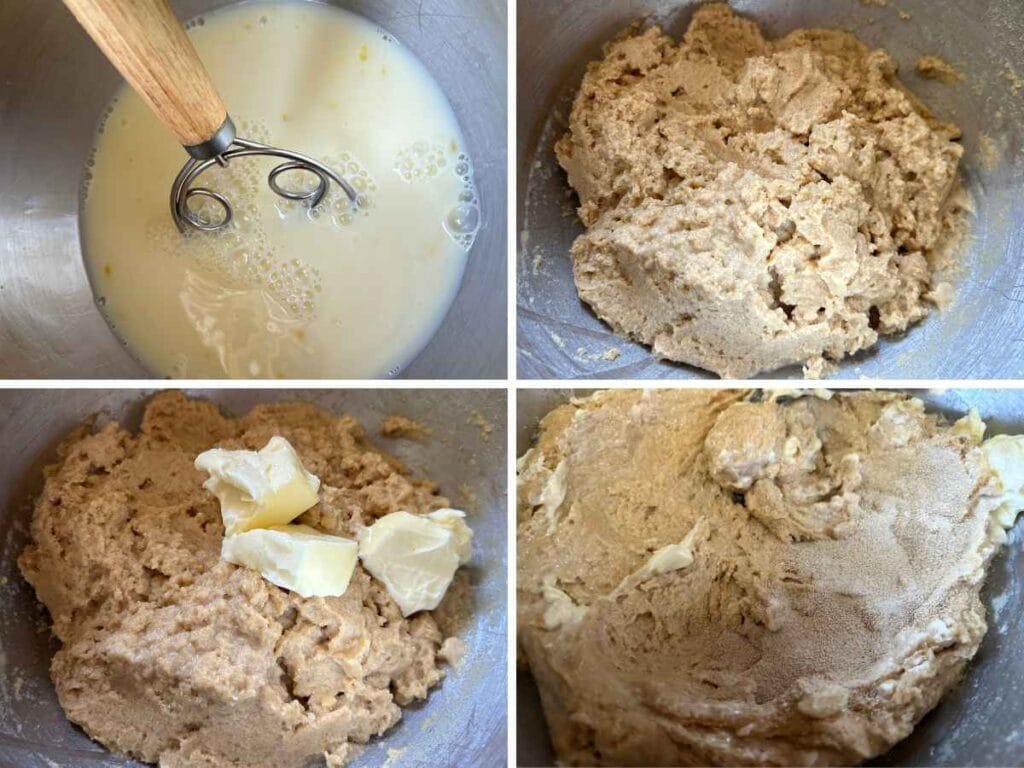
Autolyse Dough: Cover shaggy dough and autolyse (rest) for 30 minutes. Since fresh-milled flour has the bran & germ, this rest helps hydrate the flour, so the dough isn’t grainy. After the autolyse, add in butter, then yeast and salt.
Knead and Bulk Rise: Knead dough for about 5-7 minutes, or until it is smooth and stretchy. It may remain a bit sticky. Cover and let rise until doubled. This will take about 1 hour, depending on your house temperature.
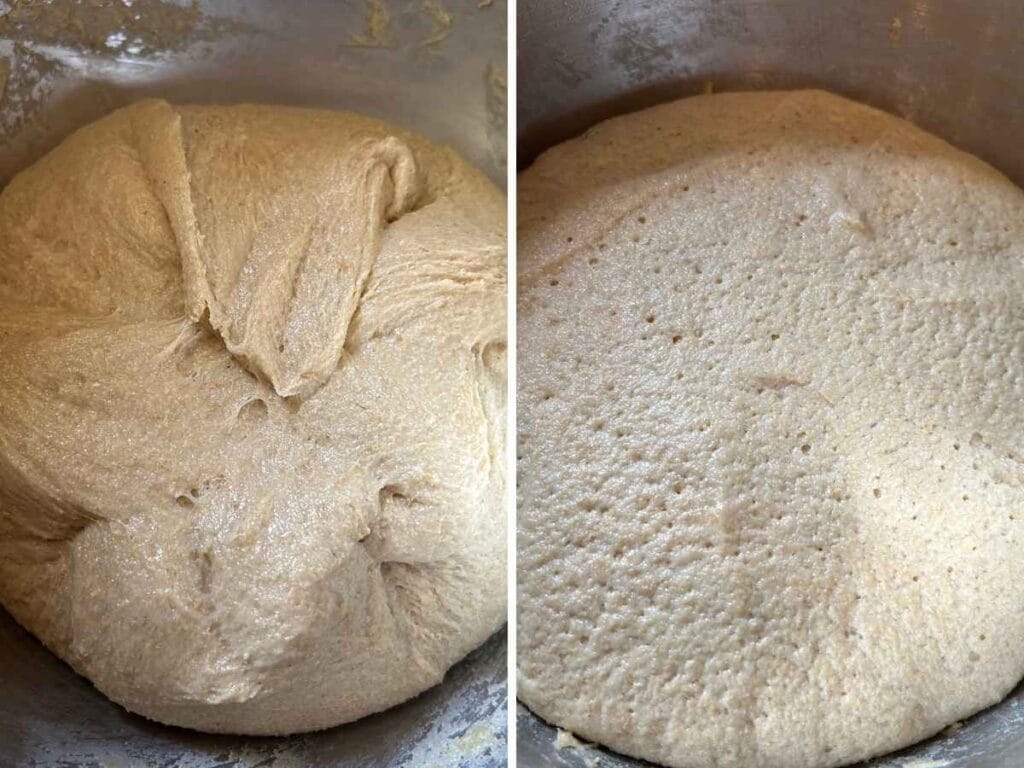
Roll Dough: Dump dough onto a lightly floured surface (I like to use rice flour), fold it in half, then gently roll out with a rolling pin to about 3/4 – 1 inch thick. Try not to push too much air out of the dough; we want to keep those beautiful nooks intact.
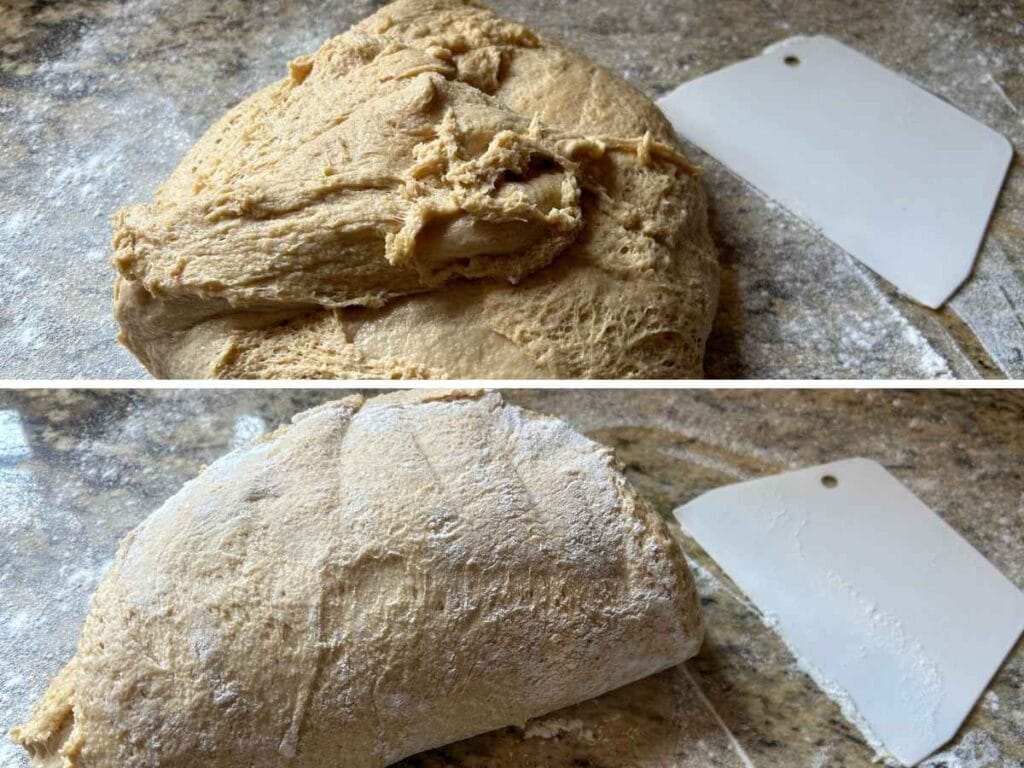
Cut Dough: Cut muffins with a floured 3″ cutter. Reshape any leftover dough, reroll, and cut.
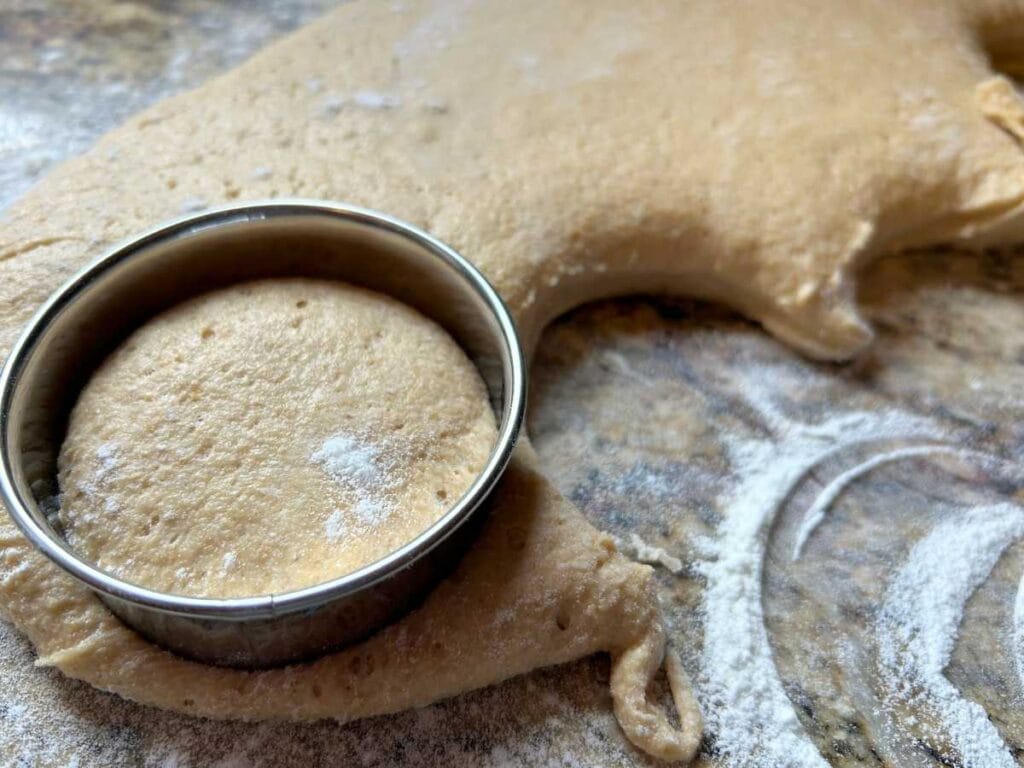
Second Rise: Place cut muffins on a tray dusted with cornmeal or rice flour. Cover with plastic wrap and let rise 15-30 minutes, or until puffed. When done rising, sprinkle with cornmeal or rice flour.
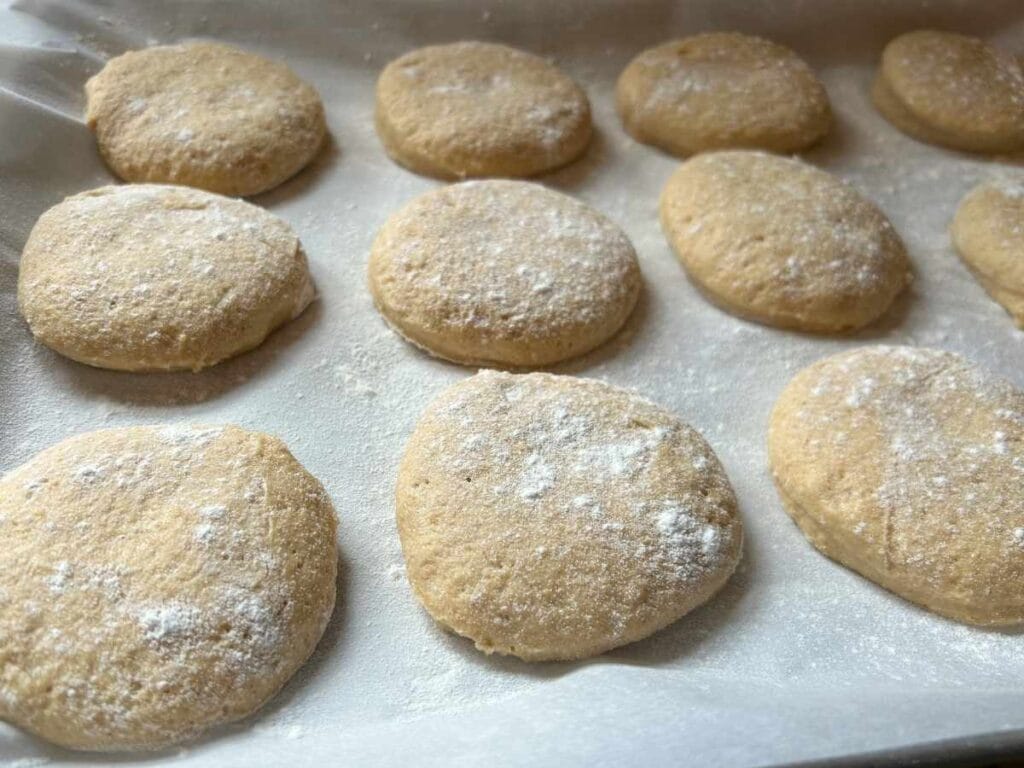
Cooking Muffins
Cook: While the dough is on the second rise, heat a cast-iron pan on medium-low, or an electric griddle on 325 degrees. Dust the cooking surface lightly with cornmeal or rice flour right before cooking.
Place muffins on preheated surface and cook on one side for 5-7 minutes, or until golden brown, then flip and cook the other side for another 5-7 minutes. Internal temperature should be at least 200 degrees. Mine usually end up between 205-210 degrees.
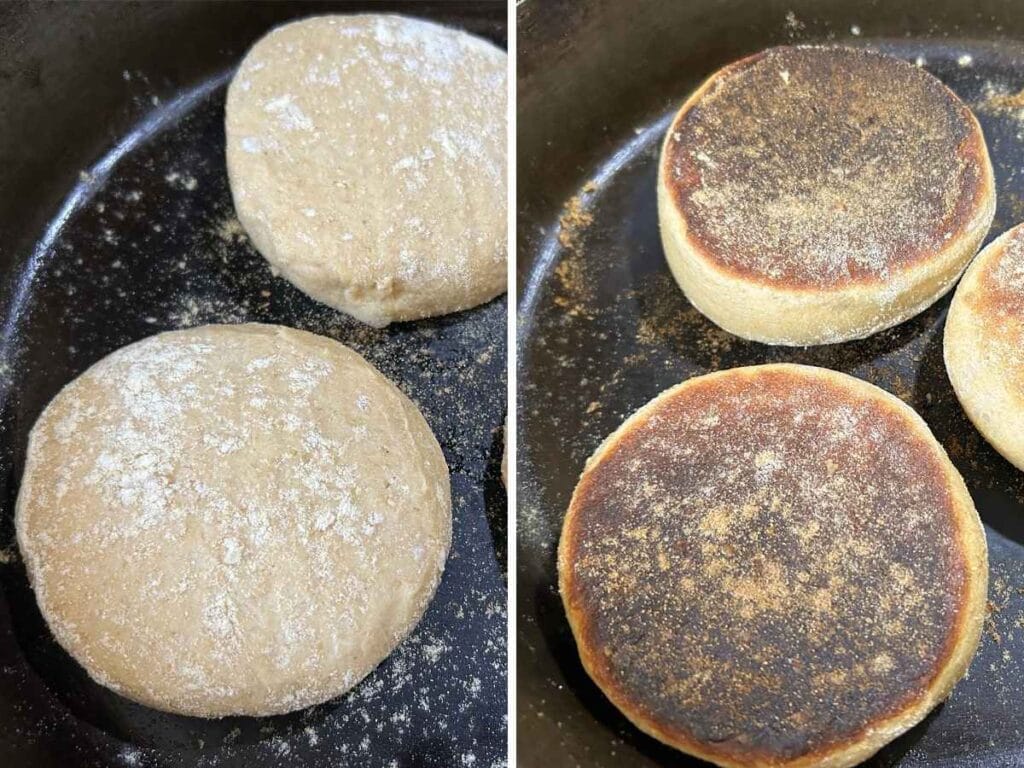
Cool: Place cooked muffins on a cooling rack. Let cool at least 30 minutes before cutting open, so they don’t get gummy.
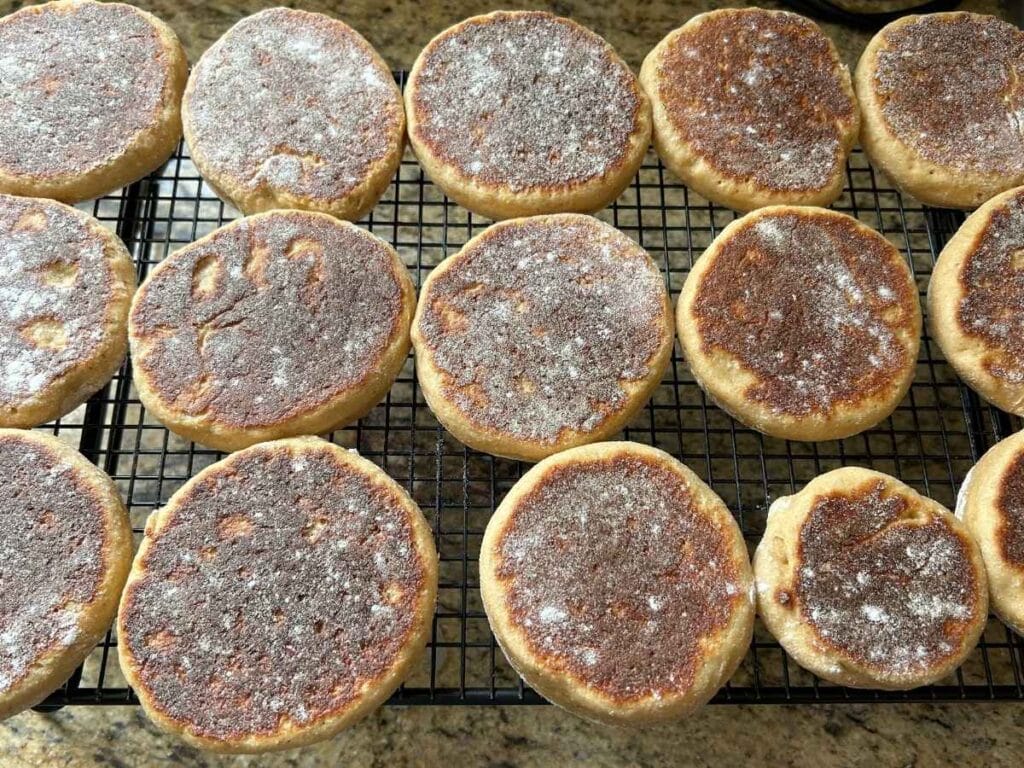
Slice & Serve: Split with a fork to keep the air pockets from flattening, then load with butter, eggs, jam, etc.
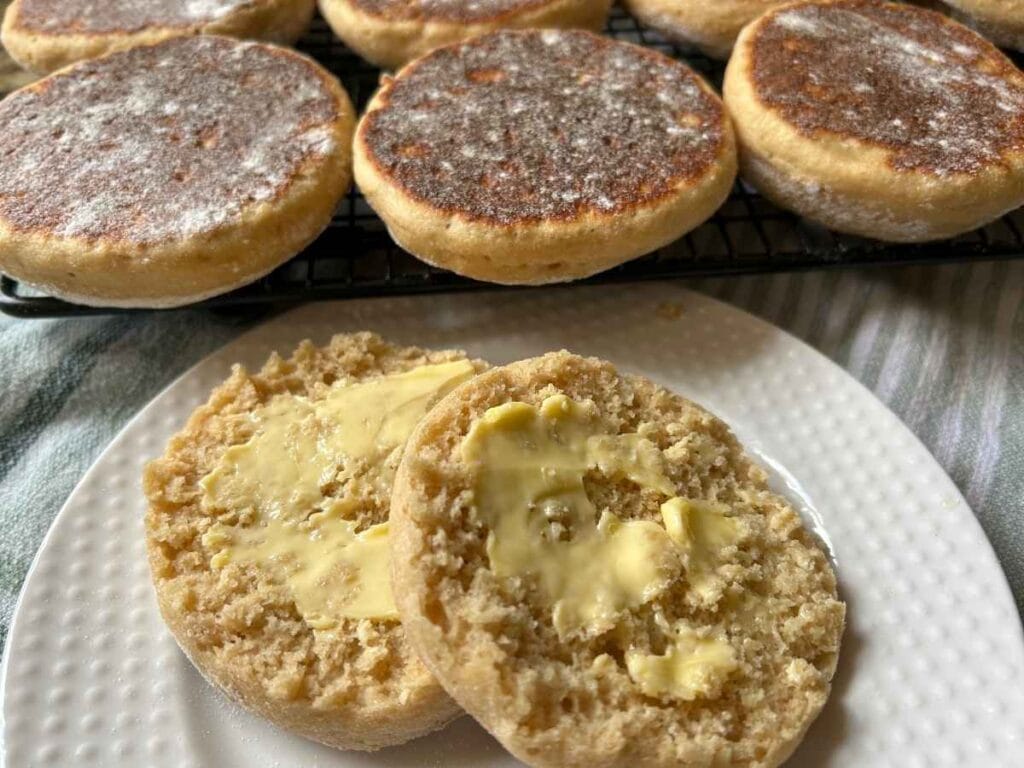
Variations
This healthy English muffin recipe gives you perfect muffins on their own, but you may want to try using different whole grains or ancient grains. Try using hard red wheat, spelt, or even einkorn mixed with your hard wheat for a different flavor & lighter crumb. You may need to play with the ratios.
For a cheesy version, add a handful of grated sharp cheddar and some chopped chives. Or give a sweet version a go with a teaspoon of cinnamon + a bit more honey + raisins. Throw some fresh herbs and spices like rosemary, garlic powder, or onion powder into the dough, or you can brush an herb butter after cooking.
Overnight rise/cold ferment: After mixing and kneading, refrigerate the dough overnight to bulk rise. It deepens the flavor. Let it warm and rise the next morning. Want a sourdough version? Try our Sourdough English Muffins.
Homemade fresh-milled flour English muffins aren’t just a recipe—they’re a breakfast upgrade. Once you go this route, you really taste the difference. Your taste buds (and family) will thank you. Delight in these soft, chewy English muffins made with fresh-milled flour!
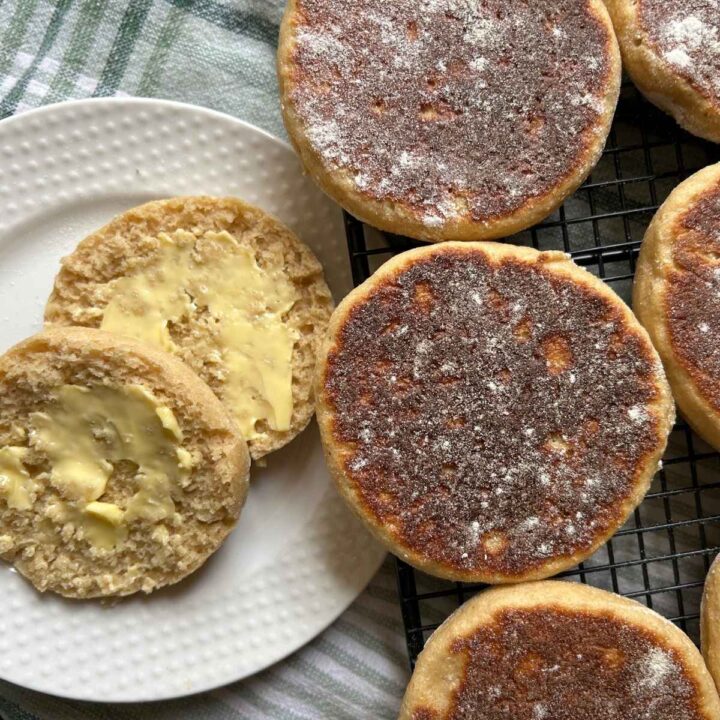
Easy Homemade English Muffins with Fresh Milled Flour
Soft, chewy English muffins made with fresh-milled flour. This easy recipe yields perfect nooks and crannies, plus flavor & nutrition!
Ingredients
- 425 grams Warm Milk (1.75 Cups)
- 43 grams Unsalted Butter (3 Tablespoons), softened
- 6 grams Salt (1.25 teaspoons)
- 25 grams Honey (2 Tablespoons)
- 1 Egg
- 250 grams Hard White Wheat Berries (1.25 Cups)
- 250 grams Kamut Berries (1.25 Cups + 1 Tablespoon)
- 6 grams Active Dry Yeast (2 teaspoons)
- Cornmeal or Rice Flour for dusting
Instructions
- Mix Dough: Whisk together warm milk, honey, and egg. Mill flour into wet ingredients and mix until you have a shaggy dough.
- Autolyse Dough: Cover shaggy dough and autolyse (rest) for 30 minutes. Since fresh-milled flour has the bran & germ, this rest helps hydrate the flour, so the dough isn’t grainy. After the autolyse, add in butter, then yeast and salt.
- Knead and Bulk Rise: Knead dough for about 5-7 minutes, or until it is smooth and stretchy. It may remain a bit sticky. Cover and let rise until doubled. This will take about 1 hour, depending on your house temperature.
- Roll Dough: Dump dough onto a lightly floured surface (I like to use rice flour), fold it in half, then gently roll out with a rolling pin to about 3/4 - 1 inch thick. Try not to push too much air out of the dough; we want to keep those beautiful nooks intact.
- Cut Dough: Cut muffins with a floured 3" cutter. Reshape any leftover dough, reroll, and cut.
- Second Rise: Place cut muffins on a tray dusted with cornmeal or rice flour. Cover with plastic wrap and let rise 15-30 minutes, or until puffed. When done rising, sprinkle with cornmeal or rice flour.
- Cook: While the dough is on the second rise, heat a cast-iron pan on medium-low, or an electric griddle on 325 degrees. Dust the cooking surface lightly with cornmeal or rice flour right before cooking.
- Place muffins on a preheated surface and cook on one side for 5-7 minutes, or until golden brown, then flip and cook the other side for another 5-7 minutes. Internal temperature should be at least 200 degrees. Mine usually end up between 205-210 degrees.
- Cool: Place cooked muffins on a cooling rack. Let cool at least 30 minutes before cutting open, so they don't get gummy.
- Slice & Serve: Split with a fork to keep the air pockets from flattening, then load with butter, eggs, jam, etc.
Notes
- Makes about 14 medium English muffins, depending on size
- You can make these without a mixer; you'll just need a large bowl + wooden spoon/dough whisk, and some muscle to knead
- You can use all Hard White Wheat if you don't have Kamut
- I prefer to cook my muffins on an electric griddle because I can cook 8 at a time rather than 3 at a time in a cast-iron pan.
- Cook time may vary between stovetops, pans, and griddles, so just watch your muffins carefully to prevent burning and don't use high heat!
Nutrition Information
Yield 14 Serving Size 1 muffinAmount Per Serving Calories 166Total Fat 4gSaturated Fat 2gTrans Fat 0gUnsaturated Fat 2gCholesterol 22mgSodium 191mgCarbohydrates 28gFiber 3gSugar 4gProtein 5g
*This has not been evaluated by the FDA
FAQs
For this particular recipe, yes, or you can try using store-bought milled whole wheat flour. Fresh milling gives you more flavor, more nutrients, and I promise you’ll notice the difference in aroma & texture.
Make sure to dust hands/surface lightly with flour (not too much or muffins turn dense). A little bit of stickiness is okay. Also, be sure you allow proper rest so the flour hydrates fully.
Cook muffins slowly over lower heat so the interior has time to rise and set before the outside get too brown. Don’t twist your cutter as that can seal edges and prevent a good rise and be sure not to smash the muffins when splitting—use a fork to open gently.
Yes! Cool completely, then freeze in an airtight bag. Thaw or reheat from frozen, then enjoy a toasted English muffin. They hold up great.
Use a thermometer if you have one; they should be at least 200 degrees. Otherwise, you can cut open one to test. It should be set, not doughy, with a little springiness and good browning on both sides.
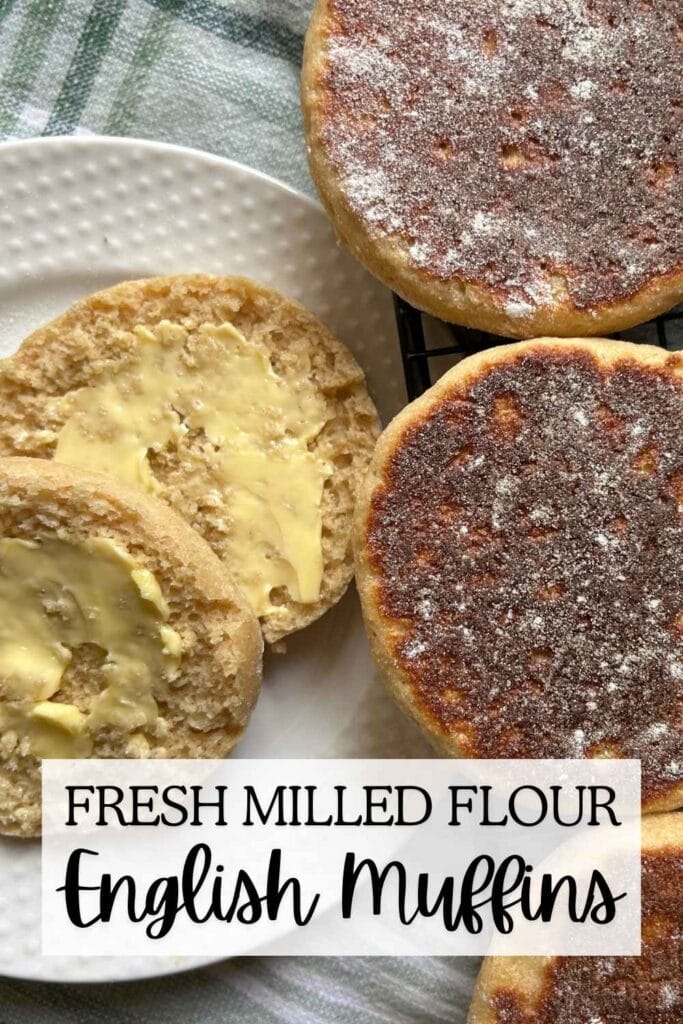







These English muffins were so easy to make! Thanks for the recipe.
Great recipe! I love homemade english muffins, they are way better than Thomas’!! It’s been too long since I had any, thanks for sharing this!